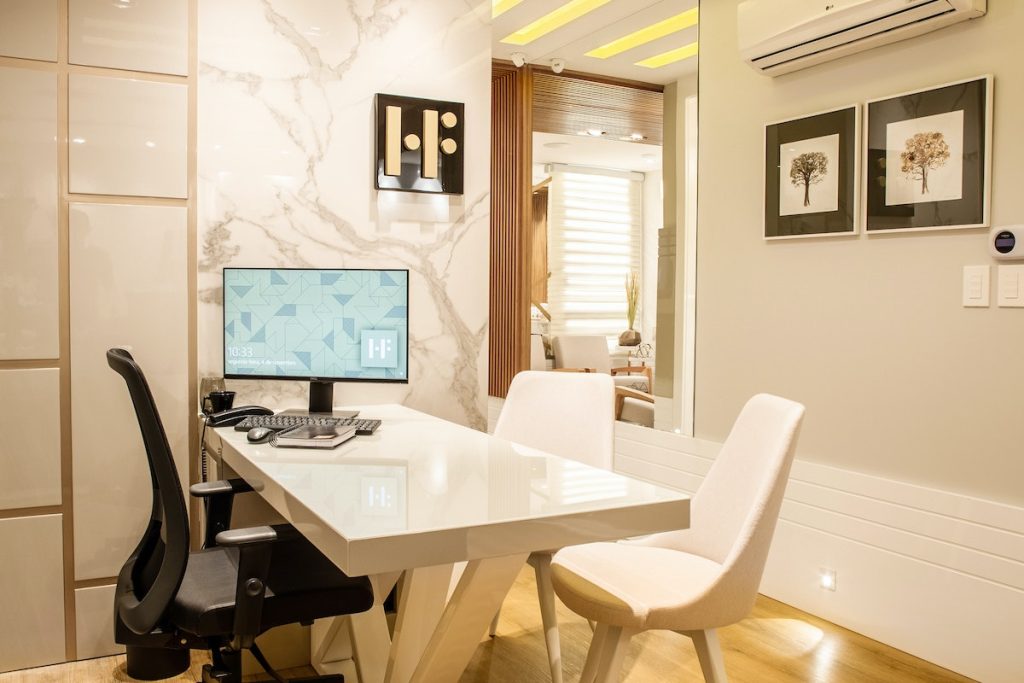- Lighting levels and color temperatures should be adjusted to meet the needs of the work environment.
- Proper office space organization and layout, including designated work areas and adequate storage, boost productivity.
- Investing in ergonomic office furniture can improve productivity, prevent work-related injuries, and increase employee satisfaction.
- Reducing workplace noise can help employees focus and collaborate better.
An office is much more than just a place where employees work. It’s where ideas are born, where creativity thrives, and where your team spends most of their day. And as an employer or manager, it’s crucial to provide a work environment that facilitates creativity and boosts employee productivity.
One of the critical aspects of creating an ideal workplace is interior design. The right office interior design can significantly impact how employees feel, engage, and work. How does this happen? Read on to find out more.
Color and Lighting
Color and lighting are critical in setting the tone for your office. Dull and dim lighting dulls the mind and affects productivity. Lighting that’s too bright may cause headaches and eyestrain. Therefore, lighting levels and color temperatures must be stationed to meet the needs of the work environment.
Similarly, the color schemes chosen can either motivate or decrease productivity. Blue and green tones are linked with calm and sustained work, and brighter colors like orange and yellow excite creativity. A well-lit and brightly colored office environment can help encourage productivity and focus.
Organization and Layout

Efficient office space organization and a proper layout can help keep employees engaged and productive. An office layout must include designated work areas, storage space, and easy access to equipment like printers and other office machinery.
In addition, opting for private cubicles give employees a place to focus and get work done. This prevents them from being distracted by noise and allows them to manage their time in their own spaces.
Ergonomics
Comfortable furniture and ergonomic office equipment are necessary for a productive work environment. An ill-suited desk or uncomfortable chair may cause aches, pains, and other long-term health effects, posing distractions and hindering staff’s focus. Here are the vital benefits:
Ergonomics can improve productivity
Investing in ergonomic office furniture can significantly improve your employees’ productivity. This is because ergonomic chairs and desks are designed to support the body’s natural posture, which can decrease discomfort and prevent back pain. When employees are comfortable, they are more likely to stay focused and produce higher-quality work.
Reduce work-related injuries
One of the main reasons employers invest in ergonomics is to reduce the risk of work-related injuries. Repetitive strain injuries (RSIs) and musculoskeletal disorders (MSDs) are common among employees who work long hours at a desk. Ergonomic furniture can prevent these damages by promoting good posture, reducing strain on joints and muscles, and minimizing discomfort.
Improved employee satisfaction
Employees who work in a comfortable and safe environment are more likely to be satisfied with their job. Investing in ergonomics will show your employees that you care about their well-being, which can boost their morale and productivity. Happy employees are also more likely to stay with your company for longer, which can improve your retention rates and reduce recruitment costs.
Workplace Noise
Noise levels significantly affect employee productivity. Heavy noise levels can lead to higher anxiety, lower levels of teamwork and coordination, less cooperation, and much annoyance in the workspace. To reduce workplace noise, you can consider the following tips:
Invest in sound-proofing materials
Adding acoustic panels or carpets to the walls will help reduce noise levels significantly. You can also place sound-absorbing furniture like couches and cushions to absorb some noise.
Encourage employees to use headphones
Headphones are an excellent way for employees to concentrate on their tasks without being disturbed by workplace noise. Encouraging your team members to wear headphones will help balance personal productivity and collaboration with colleagues.
Break Areas

Comfortable and exciting break areas can improve the employees’ sense of community and camaraderie, which boosts engagement and productivity in the workplace. Incorporating comfy chairs, fun activities, and creating social spaces are essential to employee morale while allowing employees to take breaks from work and come back refreshed and prepared to tackle the day.
The Bottom Line
Your office design is important in how productive your employees are throughout the day. Proper lighting, comfortable furniture, an ideal acoustic environment, and an efficient layout are just a few design elements you can incorporate into your office to increase workplace productivity.
Paying attention to your employee’s needs and preferences can create a productive work environment that fosters motivation, creativity, and cooperation. Ultimately, the right interior design and atmosphere can help your employees stay focused and ensure your company’s success.

